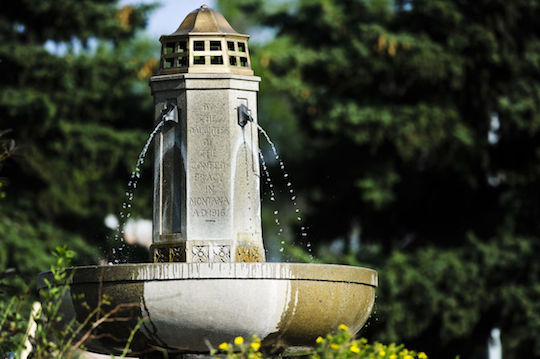The state of Montana did not participate in the US civil war. Montana didn’t become a state until decades later, in 1889, and even then it was about as far north of the Mason-Dixon line as states get. Although somebody in the Montana territory probably traveled south to fight on the side of the Confederacy, the war is only a part of this region’s history indirectly, in the same way as, say, the Boston Tea Party. There’s no statue of Sam Adams in Helena. Yet there is a memorial to Confederate soldiers, given to the city by The Daughters of the Confederacy in 1915.
In a letter to city commissioners, eight members of the state legislature’s American Indian Caucus recently asked that the fountain be removed. Helena Mayor Jim Smith opposes this idea. In his own letter, reported by Holly Michels1 in the Helena Independent-Record, he writes, “Fundamentally, I believe we ought to be very careful before we start obliterating history. That is what totalitarian regimes do.”
Let’s talk about what constitutes history, then. The notion that statues and fountains somehow stand between us and the “obliteration” of history is fatuous. I defy you to show me someone who only knows about the Civil War from a statue. And what information about history does the fountain in Hill Park convey? If you did not know anything about the past, all this monument would tell you is that there once existed a group called The Daughters of the Confederacy, and it dedicated a fountain in 1915.
That fountain is less a piece of history than a monument to one group’s understanding of it. The distinction is important. The D of the C built this monument 50 years after the Civil War ended. That’s an astonishingly short time, like erecting a monument to the Wehrmacht in Paris in 1995. But it is still two generations after the Confederacy ceased to exist, and the fountain cannot meaningfully be called a relic of Civil War history. Instead, it is a monument to the City of Helena’s endorsement of the Daughters of the Confederacy in 1915.
That moment is also part of history, but it is not important in the same way as the Civil War. I don’t think anyone considers it a significant part of the story of Helena. It has purely symbolic importance, and what it symbolizes—then and now—is not something the city should support, even if only by inaction.
The Daughters of the Confederacy was founded to sponsor burials of Confederate veterans, erect monuments to them, and influence schools to teach Civil War history in ways that reflected favorably on the South. Its membership increased dramatically during the first two decades of the 20th century, going from 17,000 in 1900 to almost 100,000 by the outbreak of World War I. The fountain in Hill Park reflects the height of the Daughters’ influence. It also reflects a sympathy to their cause completely divorced from history.
Again, Montana played no part in the Civil War. If it had existed as a state, it would have almost certainly fought for the North. It had no historical ties to the Confederacy, in 1863 or in 1915. The fountain therefore suggests an affinity for some other aspect of the Daughters’ mission. It is hard to say what that could be other than white supremacy.
Many historians, including Princeton professor and Pulitzer Prize winner James McPherson, consider the Daughters of the Confederacy a stalking horse for white supremacy. It’s not inconceivable that some of the Daughters are lineal descendants of Confederates who only want to memorialize their ancestors, but that argument breaks down in Montana. The further we get, geographically and chronologically, from the Confederacy itself, the more structures like this fountain become monuments to the idea and not the history.
That idea is repugnant. Confederate soldiers fought a war of treason against the United States in defense of slavery. There are a lot of good reasons to study that war and remember it, to literally memorialize the history. But there are only two reasons to memorialize the ideas: either you like the notion of exploiting and disenfranchising black people by force, or you like the notion of betraying the United States and killing its citizens.
There is a third reason, of course: you recognize that Confederate monuments have some vague appeal to disgruntled white people, and you’re pandering. I hope that’s what Mayor Smith is up to. I would hate to think he is a slavemonger or seditionist. He has probably just performed the same calculus the city fathers did in 1915. Most of Helena is white, and saying yes to some cracker nonsense will alienate fewer voters than saying no. The next step in this process, probably, is to prove him wrong.





If you want it removed “remove this symbol of shameful ideas” is one tact. Another is to make it an embarrassing symbol by changing people’s ideas. When what the fountain symbolizes is in dispute (The idea of valor! No, human bondage! No, government tyranny! No, racial exploitation!) I think people are bound to have intractable disagreement.
Democratic voting avails us of this problem, allowing us to add up all the people who find the monument embarrassing against the people who find it valuable. So make it a prominent embarrassment. The American Indian Caucus should start a social media campaign. Upload instas to tumbler with #daughtersofracism and #NoCompassionNoConfederacy. Change what it symbolizes to Helenians.
It’s a piece of stone that spits water and sounds nice when you walk by. 90% of people probably walk by it without reading shit. Don’t remove it as a way to change people’s ideas. This kind of shit is just shortsighted and embarrassing: http://www.cnn.com/2017/08/14/us/confederate-statue-pulled-down-north-carolina-trnd/index.html
Today cities are reviewing their stance on free speech and assembly. Helena’s Confederate Fountain is again under attack. I believe it should remain where it is located. To me it is a symbol of peace and reconciliation after our bloody Civil War. It does not glorify white slave-owners as some other memorials do. This is a clear and significant difference. Helena should celebrate its diversity and tolerance.
Sounds like the author knows very little of the history of the state. Many settlers came from the south after the civil war. Hence some of the place names like Confederate Gulch, Varina, etc. Opinions are great, but if you don’t know the background of what you are writing about there is no point. Interesting fact, then President Bill Clinton did a review of the Daughters of the Confederacy and said they weren’t a hate group, he even lauded the work they had done caring for the graves of the fallen.
The opinion expressed in the article is only that of the the writer, which I would consider very bias. The Civil War was not about slavery and most of those confederate soldiers, indeed the vast majority, were pressed into service, mainly by social pressure. If they had been born in the North they would have served the Union. That is the tragedy of civil war.They served the Confederacy because that is where they lived. By taking down statues, where does one stop? Let’s take down statues and monuments simply because we do not believe or support who that person was or of that event! Just a personal opinion that we endeavour in our vanity to thrust on all others. The trend becomes dangerous. Trump is quite right…why not Washington or Lincoln? The taking down of the statues and the vandalism of monuments is purely political by those who are working on a political and social agenda.
It just seems ludicrous to find a monument symbolizing the civil in Montana. It wasn’t even a state then. Yes there was probably settlers there as refugees from the south. But the South lost that war. So it seems extra weird to have a monument symbolizing some of the losers. I guess since it was a freebie & there weren’t any black ppl around to worry if it was offensive made it ok. But it really wasnt then & isnt now.
The irony here is that the Doughters of the Confederacy were the prime destroyers of history in 1915. Rewriting the past was the job of that organization. No, it didn’t have anything to do with slavery. It was about some odd idea that the South fought the war to defend its “heritage.” Now, the slaveholders who were possessors of the most valuable capital asset in America at that time, the bodies of four million slaves. That’s the truth. And Lincoln had seen that a “nation could not long endure, half slave and half free.” Having lived some of my life in the South, I think I know something of that heritage. Fine cooling, fine writers, fine music— as long as you count the invention of jazz and blues in that, and wonderful country artists as well— and creole cooking and jambalaya too. But what that has to do with falsifying the truth of the civil war, in an almost Stalinist way, from the destruction of Reconstruction to the ascendancy if Jim Crow and the heyday of the Klan, I do not know. My great-grandfather worked in the mine in Butte until he died from a piece of shrapnel he got on the approach to Atlanta. He belonged the the GAR Lodge in Butte, and he named his son, my grandfather, Thaddeus, after the Speaker of the House, Thaddeus Stevens, who helped pass the 13th and 14th Amendments. That’s what he called his heritage, and that was no fake.
Helena (Last Chance Gulch-gold) was discovered and initial settlement was by the Four Georgians. Don’t try to pretend you understand the folks of Helena from a distance. The fountain’s history was known by very few folks and stood as a symbol for beauty in a park that now has none. Removing historical monuments is the work of cowards.